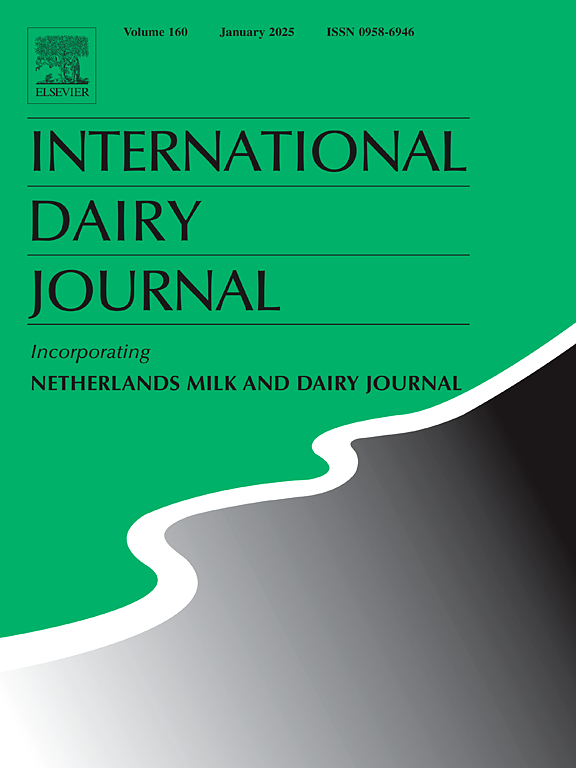基于非靶向代谢组学的绵羊、山羊和牛奶的比较分析
IF 3.4
3区 农林科学
Q2 FOOD SCIENCE & TECHNOLOGY
引用次数: 0
摘要
羊奶含有丰富的乳脂、乳蛋白、维生素和矿物质,也是天然生物活性物质的重要来源。近年来,人们对羊奶的食品和药物功能进行了探索,因此了解羊奶中的特定代谢物对于研究其特定功能具有重要意义。在本研究中,我们对绵羊、山羊和牛奶进行了常规成分分析,并使用非靶向代谢组学来量化牛奶代谢物和相关代谢途径的差异。绵羊奶中的脂肪、非脂肪固体、蛋白质和总固体含量显著高于山羊奶和牛奶(P <;0.05)。在绵羊和山羊奶中共鉴定出178种代谢物,其中74种丰度较高,104种浓度较低。在羊奶和牛奶中共鉴定出223种代谢物,其中80种丰度较高,143种浓度较低。结果表明,羊奶与其他牛奶样品代谢物的主要差异是脂类、脂类类似物、有机酸及其衍生物、有机杂环化合物、核苷酸、核苷酸及其类似物,并通过KEGG分析鉴定,主要富集于代谢途径。这一结论与本实验室前期的研究结果一致,即饲粮羊奶可以改善脂质代谢。本研究确定了羊奶与牛奶、山羊奶的差异代谢物,为后续研究羊奶中特定的生物活性物质及其功能奠定了基础。本文章由计算机程序翻译,如有差异,请以英文原文为准。
Comparative analysis of sheep, goat, and cow milk based on non-targeted metabolomics
Sheep milk is rich in milk fat, milk protein, vitamins, and minerals, and is also an important source of natural bioactive substances. In recent years, the food and drug functions of sheep milk have been explored, so it is important to understand the specific metabolites in sheep milk in order to study its specific functions. In this study, we performed routine composition analysis of sheep, goat, and cow milk, and non-targeted metabolomics was used to quantify differences in milk metabolites and related metabolic pathways. The contents of fat, non-fat solids, protein, and total solids in sheep milk were significantly higher than those in goat and cow milk (P < 0.05). In total, 178 metabolites were identified in sheep and goat milk, of which 74 were elevated abundance and 104 were lower concentration in sheep milk. In total, 223 metabolites were identified in sheep and cow milk, of which 80 were elevated abundance and 143 were lower concentration in sheep milk. The results indicated that the main differences in metabolites between sheep milk and other milk samples were lipids, lipid analogues, organic acids and their derivatives, organic heterocyclic compounds, nucleotides, nucleotides and their analogues, and were identified through KEGG analysis, mainly enriched in metabolic pathways. This conclusion was consistent with the previous research results of our laboratory that dietary sheep milk can improve lipid metabolism. This study identified the differential metabolites between sheep milk and cow milk as well as goat milk, laying a foundation for subsequent research on the specific bioactive substances and their functions in sheep milk.
求助全文
通过发布文献求助,成功后即可免费获取论文全文。
去求助
来源期刊

International Dairy Journal
工程技术-食品科技
CiteScore
6.50
自引率
9.70%
发文量
200
审稿时长
49 days
期刊介绍:
The International Dairy Journal publishes significant advancements in dairy science and technology in the form of research articles and critical reviews that are of relevance to the broader international dairy community. Within this scope, research on the science and technology of milk and dairy products and the nutritional and health aspects of dairy foods are included; the journal pays particular attention to applied research and its interface with the dairy industry.
The journal''s coverage includes the following, where directly applicable to dairy science and technology:
• Chemistry and physico-chemical properties of milk constituents
• Microbiology, food safety, enzymology, biotechnology
• Processing and engineering
• Emulsion science, food structure, and texture
• Raw material quality and effect on relevant products
• Flavour and off-flavour development
• Technological functionality and applications of dairy ingredients
• Sensory and consumer sciences
• Nutrition and substantiation of human health implications of milk components or dairy products
International Dairy Journal does not publish papers related to milk production, animal health and other aspects of on-farm milk production unless there is a clear relationship to dairy technology, human health or final product quality.
 求助内容:
求助内容: 应助结果提醒方式:
应助结果提醒方式:


